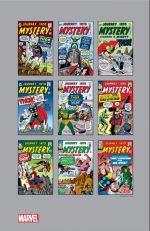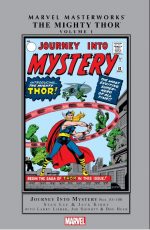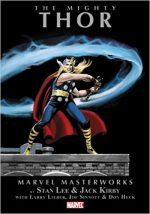


By Stan Lee, Jack Kirby, Larry Lieber, Robert Bernstein, Joe Sinnott, Al Hartley, Don Heck & various (Marvel)
ISBN: 978-0-7851-1267-9 (HB)Â Â Â Â Â Â Â Â Â Â Â Â Â Â Â Â Â Â Â : 978-0-7851-4568-4 (TPB)
The Mighty Thor was the comic series in which Jack Kirby’s restless fascination with all things Cosmic was honed and refined through his dazzling graphics and captivating concepts. The King’s examination of space-age mythology began in a modest little fantasy/monster title called Journey into Mystery where – in the summer of 1962 – a tried-and-true comicbook concept (feeble mortal transformed into god-like hero) was revived by the fledgling Marvel Comics to add a Superman analogue to their growing roster of costumed adventurers.
This spectacular tome – in hard cover, trade paperback and eFormats – re-presents those pioneering Asgardian exploits from JiM #83-100, spanning August 1962 to January 1964 in a blur of innovation and seat-of-the-pants legend-revising and universe-building…
Following a typically frothy Introduction from Stan Lee, the wonderment begins with the lead tale from anthological Journey into Mystery #83, which saw a bold costumed warrior jostling aside the regular fare of monsters, aliens and sinister scientists in a brash, vivid explosion of verve and vigour.
The initial exploit followed crippled American doctor Donald Blake who takes a vacation in Norway only to encounter the vanguard of an alien invasion. Fleeing, he is trapped in a cave where he finds an old, gnarled walking stick. When in his frustration he smashes the stick into a huge boulder obstructing his escape, his puny frame is transformed into the Norse God of Thunder Mighty Thor!
Plotted by Lee, scripted by his brother Larry Lieber and illustrated by Kirby and inker Joe Sinnott (at this juncture a full illustrator, Sinnott would become Kirby’s primary inker for most of his Marvel career), ‘The Stone Men of Saturn’ is pure early Marvel: bombastic, fast-paced, gloriously illogical and captivatingly action-packed. The hugely under-appreciated Art Simek was the letterer and logo designer.
It was clear that they whey were making it up as they went along – not in itself a bad thing – and all that infectious enthusiasm shows in the next adventure…
‘The Mighty Thor Vs. the Executioner’ is a “commie-busting†tale of its time with a thinly disguised Fidel Castro wasting his formidable armies in battle against our hero. Dr. Blake’s nurse Jane Foster debuts; a bland cipher adored from afar by the Norse superman’s timid alter-ego.
The creative team settled as Dick Ayers replaced Sinnott, and with #85’s ‘Trapped by Loki, God of Mischief!’ the final element fell into place with the “return†of a suitably awesome arch-foe; in this case the hero’s half-brother. The evil magician and compulsive trickster escaped divine incarceration and his first thought was to bedevil Thor by causing terror and chaos on the world of mortals he was so devoted to…
Here a new and greater universe was first revealed with the tantalising hints and glimpses of the celestial otherworld and more Nordic gods…
Issue #86 introduced another recurring villain. Zarrko, bristling at the sedentary ease of 23rd century life, voyages back to 1962 and steals an experimental “C-Bombâ€, forcing the Thunderer into a stirring hunt through time and inevitable clash with super-technology ‘On the Trail of the Tomorrow Man!’
On his return Blake became a target of Soviet abductors. Those sneaky spies even managed to make Thor a ‘Prisoner of the Reds!’ before our epic warrior eventually emerges unscathed and triumphant…
‘The Vengeance of Loki’ sees the god of Mischief’s return in #88: a malevolent miscreant uncovering Thor’s secret identity and naturally menacing Jane Foster after which ‘The Thunder God and the Thug’ offers adventure on a much more human scale as a gang boss runs riot over the city and roughshod over a good woman’s heart, giving the Asgardian a chance to demonstrate his more sophisticated and sympathetic side by crushing Thug Thatcher and freeing her from his brutal influence.
Issue #90 was an unsettling surprise as the grandeur of Kirby & Ayers was abruptly replaced by the charming yet angst-free art of Al Hartley, who illustrated Lee & Lieber’s stock alien-invasion yarn ‘Trapped by the Carbon-Copy Man!’ A month later the Storm Lord tackles ‘Sandu, Master of the Supernatural!’, with Sinnott handling pencils and inks in a thriller starring a carnival mentalist who – augmented by Loki’s magic – comes catastrophically close to killing our hero…
Sinnott illustrated JiM #92’s ‘The Day Loki Stole Thor’s Magic Hammer’ (scripted by Robert Bernstein over Lee’s plot) which moves the action fully to the mythical realm of Asgard for the first time as Thor seeks to recover his stolen weapon after Loki enchants the magnificent mallet.
Kirby & Ayers momentarily returned for Cold War/Atom Age thriller ‘The Mysterious Radio-Active Man!’ – again scripted by Bernstein – as Mao Tse Tung unleashes an atomic assassin in retaliation for Thor thwarting China’s invasion of India.
Such “Red-baiting†was common in early Marvel titles, but their inherent jingoistic silliness can’t mar the eerie beauty of the artwork. With this tale the rangy, raw-boned Thunder God completed his slow metamorphosis into the husky, burly blonde bruiser who dominated any panel he was drawn in.
Sinnott illustrated the next three somewhat pedestrian adventures, ‘Thor and Loki Attack the Human Race!’, ‘The Demon Duplicator’ and ‘The Magic of Mad Merlin!’, but these mediocre tales of magic-induced amnesia, scientifically-manufactured evil doppelgangers and an ancient mutant menace were the last of an old style of comics. Lee took over full scripting with Journey into Mystery #97 and a torrent of awesome action wedded to soap opera melodrama resulted in a fresh style for a developing readership.
‘The Lava Man’ in #97 was again drawn by Kirby, with the subtly-textured inking of Don Heck adding depth to the tale of an invader summoned from the subterranean realms to menace humanity at the behest of Loki. More significantly, a long running rift between Thor and his stern father Odin is established after the Lord of Asgard refuses to allow his son to love the mortal Jane.
This acrimonious triangle was a perennial sub-plot fuelling many attempts to humanise Thor, because already he was a hero too powerful for most villains to cope with. Most importantly this issue was notable for the launch of a spectacular back-up series. Tales of Asgard – Home of the mighty Norse Gods gave Kirby a vehicle to indulge his fascination with legends.
Initially adapting classic fables of the Elder Eddas but eventually with all-new material particular to the Marvel pantheon, he built his own cosmos and mythology, to underpin the company’s entire continuity. This first yarn, scripted by Lee and inked by George Bell (AKA old Golden Age collaborator George Roussos), outlined the origin of the world and the creation of the World Tree Yggdrasil.
‘Challenged by the Human Cobra’ introduced the serpentine villain (bitten by a radioactive cobra, would you believe?) in a tale by Lee & Heck, whilst Kirby – with them in attendance – offered ‘Odin Battles Ymir, King of the Ice Giants!’: a short, potent fantasy romp laying more groundwork for decades of cosmic wonderment to come.
The same format held for issues #99 and #100 with the main story (the first 2-part adventure in the run) introducing the ‘Mysterious Mister Hyde’ – and concluding a month later with ‘The Master Plan of Mr. Hyde!’
The modern yarn dealt with a contemporary chemist who could transform into a super-strong villain at will who frames Thor for his crimes, whilst in primordial prehistory Kirby detailed Odin’s war with ‘Surtur the Fire Demon’ and latterly (with Vince Colletta inking) crafted an exploit of the All-Father’s so different sons in ‘The Storm Giants – a tale of the Boyhood of Thor’. As always, Lee scripted these increasingly influential comicbook histories…
These early tales of the God of Thunder reveal the development not only of one of Marvel’s core narrative concepts but, more importantly, the creative evolution of perhaps the greatest imagination in comics. Set your common sense on pause and simply wallow in the glorious imagery and power of these classic adventures for the true secret of what makes comicbook superheroes such a unique experience.
© 1962, 1963, 1964, 2017 Marvel Characters, Inc. All rights reserved.
